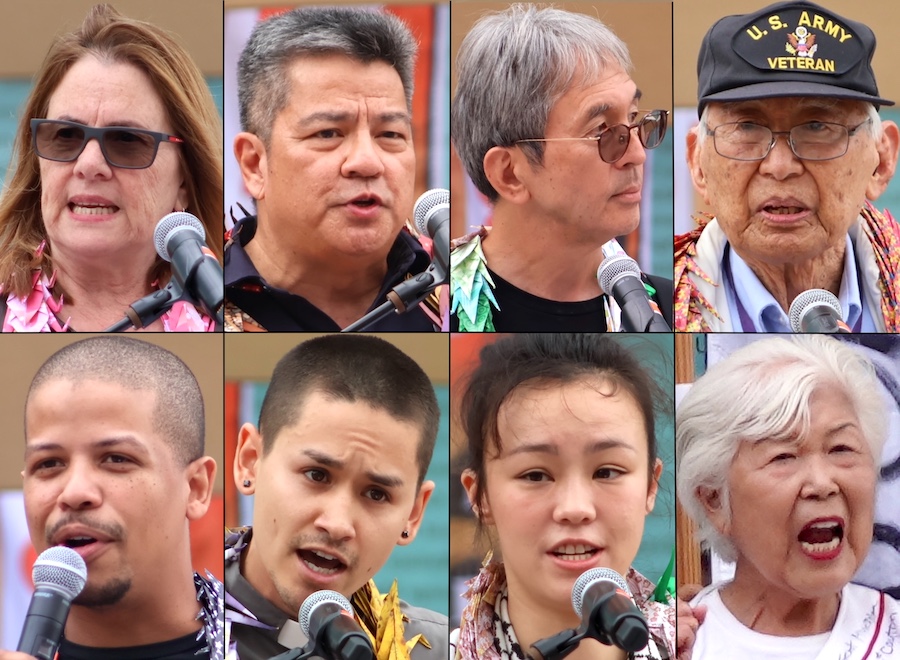
Pictured speakers from the Los Angeles Day of Action (clockwise from upper left) are Ann Burroughs, Dennis Arguelles, Glen Kitayama, Tak Hoshizaki, Kyoko Oda, Abigail Chun, Rev. Yoshi Kuramoto and Vlad Carrasco. (Photos: George Toshio Johnston)
NPCA’s nationwide gatherings include the Japanese American community.
By P.C. Staff
The Japanese American community response to President Donald Trump’s March 27 Executive Order 14253 manifested itself late last month at five sites, some under the stewardship of the Interior Department’s National Parks Service.
The gatherings were part of the larger National Day of Action, set in motion by the nonprofit National Parks Conservation Assn., which is dedicated to protecting America’s parks for the future and is unaffiliated with the NPS.
Several Japanese American organizations, including JACL, gathered at four separate sites on Aug. 23 — Little Tokyo, Seattle, Manzanar National Historic Site and Tule Lake National Monument — and on Aug. 25 at the Rosie the Riveter/WWII Home Front National Historical Park in Richmond, Calif., to speak out against the decree, titled “Restoring Truth and Sanity to American History.”
The order seeks to “ensure that all public monuments, memorials, statues, markers or similar properties within the Department of the Interior’s jurisdiction do not contain descriptions, depictions or other content that inappropriately disparage Americans past or living (including persons living in colonial times)” (see tinyurl.com/me3ub22p).
On May 20, Interior Secretary Doug Burgum’s Secretarial Order 3431 (tinyurl.com/k969yhtb) implemented E.O. 14253 by installing means, including QR codes, by which visitors could report for removal of or changes to signage at NPS sites that might “inappropriately disparage” someone, even if historically factual or accurate.
Following are reports on activities that took place on Aug. 23 in Seattle, Manzanar and Los Angeles.
Seattle
On a beautiful and sunny Saturday morning, more than 200 people gathered at the Overlook Walk of the Waterfront Park on the shores of Elliot Bay in Seattle for the Protect Every Park Gathering.
The event took place just across the water from Bainbridge Island, which was the first place where Japanese Americans were forcibly removed from their homes and sent to government-operated concentration and internment camps. Some of those former camps — Manzanar, Minidoka, Tule Lake, Amache and Honouliuli — are now National Historic Sites operated by the NPS and thus potentially affected by Trump’s executive order.
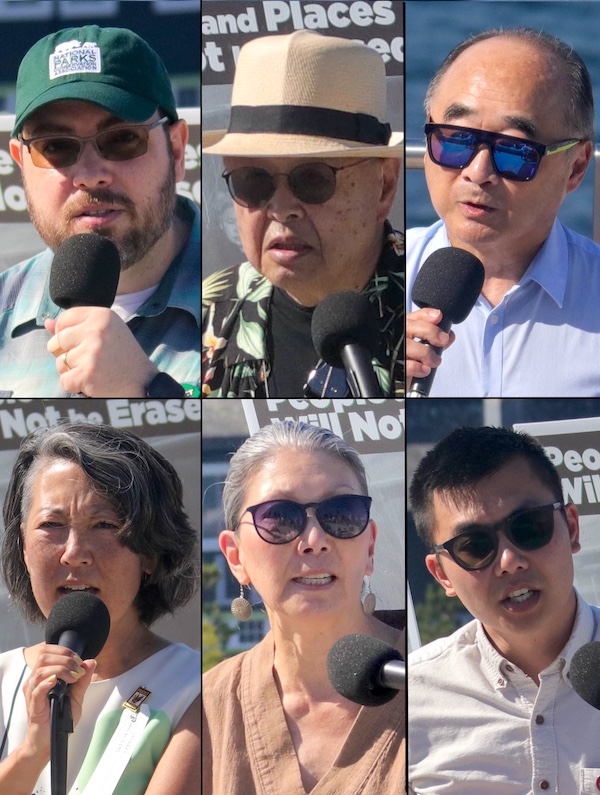
Pictured (clockwise from upper left) are Graham Taylor, Dr. Lawrence Matsuda, Bainbridge Island Councilman Clarence Moriwaki, Huy Pham, Washington State Rep. Sharon Tomiko Santos and Erin Shigaki. (Photos: Courtesy of Ryan Kozu)
This hourlong event featured taiko drumming by Matsuri Taiko and addresses by NCPA’s Graham Taylor; Dr. Lawrence Matsuda; Bainbridge Island Councilman Clarence Moriwaki; Huy Pham of Asian & Pacific Islander Americans in Historic Preservation; Washington State Rep. Sharon Tomiko Santos (D–37th District); and Erin Shigaki of the Minidoka Pilgrimage Planning Committee and Tsuru for Solidarity.
The overall sentiment for the day was summed up best by Pham, who said, “We want parks, not prisons! Park Rangers, not ICE agents!”
Manzanar
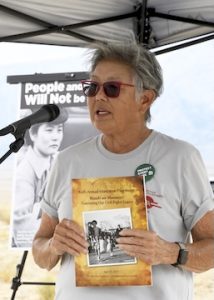
Pat Sakamoto (Photo: Courtesy of Manzanar Committee)
According to the Manzanar Committee, approximately 125 people showed up for the National Day of Action that took place on a cloudy day at the Manzanar National Historic Site, located between the California towns of Lone Pine and Independence.
Inyo County Supervisor Jeff Griffiths (District 2) served as the master of ceremonies. He introduced speakers Jeremiah Joseph of the Lone Pine Paiute Shoshone Tribe; Inyo County Supervisor Jeff Griffiths (District 2); Manzanar Committee Co-Chair Bruce Embrey; Bernadette Johnson of National Parks Conservation Assn.; Manzanar survivor Pat Sakamoto; Virginia Figueroa and Fran Hunt of climate action and environmental protection nonprofit Inyo 350; Wendy Schneider of Friends of the Inyo; and Noah Williams of the Bishop Paiute Tribe.
“They’re trying to erase our stories,” said Embrey of the motivation behind this particular executive order. “They’re trying to erase communities because our story undermines and negates their ideology.” He added, “We are especially concerned that the historic sites that tell crucial stories of our history … will be censored or shuttered.”
During his turn, Griffiths gave an interpretation of the meaning behind a painting titled “American Progress” by John Gast, which he said appears on the official social media pages of the White House and the Department of Homeland Security. “The ‘H’ in heritage and the ‘H’ in homeland are capitalized, which stands for Heil Hitler. … That is the level of the battle that we’re fighting now.”
Regarding the effort to report and remove language that might be construed as disparaging to U.S. history, NPCA’s Johnson said, “A real democracy doesn’t shy away from confronting such truths, despite how painful and unflattering. … By telling these stories, our national parks are more than just natural and cultural treasures, they are critical democratic institutions.”
On the topic of keeping stories of sites like Manzanar truthful, blemishes and all, Sakamoto, who was born at the Manzanar War Relocation Center in 1944, said there were thousands of stories that people like her late mother, for whom she promised to be the voice of, lived through. “I’m afraid they’re going to erase all of that by what’s happening now,” she said. “I won’t be able to tell my mother’s story.” (A video of the National Day of Action at Manzanar can be viewed at youtu.be/1stqDWr2Uas.)
Los Angeles
For an event that began planning just two weeks earlier, according to mistress of ceremonies Dana Fujiko Heatherton, the outcome was solid: More than 520 people gathered in front of the Japanese American National Museum for “Never Again: A National Day of Action.”

Glen Kitayama of the Manzanar Committee speaks in front of the Japanese American National Museum in Little Tokyo during the Day of Action. (Photo: George Toshio Johnston)
With the main reason for the L.A. gathering being the nationwide Day of Action that sought to keep NPS sites from sanitizing American history, the bigger picture of recent events — stepped-up Immigration and Customs Enforcement arrests, unlawful deportations, detention camps, alarm at perceived authoritarianism and fascism — was alluded to often by the speakers, drawing the assemblage to spend part of their Saturday just yards from where Americans of Japanese ancestry and their Issei parents, at the time ineligible to become naturalized U.S. citizens, had gathered in 1942 to be bussed to be incarcerated for much, if not all, of the duration of World War II.
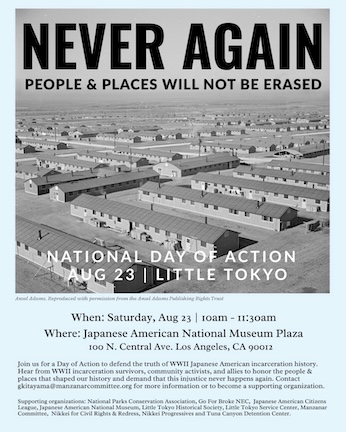 “My grandparents went through this, and our parents went through this,” said Craig Watanabe, who was present with his wife, Deborah Watanabe. “I realized it’s happening again. Things never change — and it’s got to change.”
“My grandparents went through this, and our parents went through this,” said Craig Watanabe, who was present with his wife, Deborah Watanabe. “I realized it’s happening again. Things never change — and it’s got to change.”
Watanabe made that remark within spitting distance of not just what happened in 1942 but also just feet from where, on Aug. 14, dozens of armed and masked Border Patrol agents arrived as Gov. Gavin Newsom held a news conference inside the Daniel K. Inouye National Center for the Preservation of Democracy’s Tateuchi Democracy Forum to announce his drive for a temporary redistricting initiative to counterbalance Texas’ mid-decade redistricting effort at Trump’s request (See article in this issue and tinyurl.com/3srpcand).
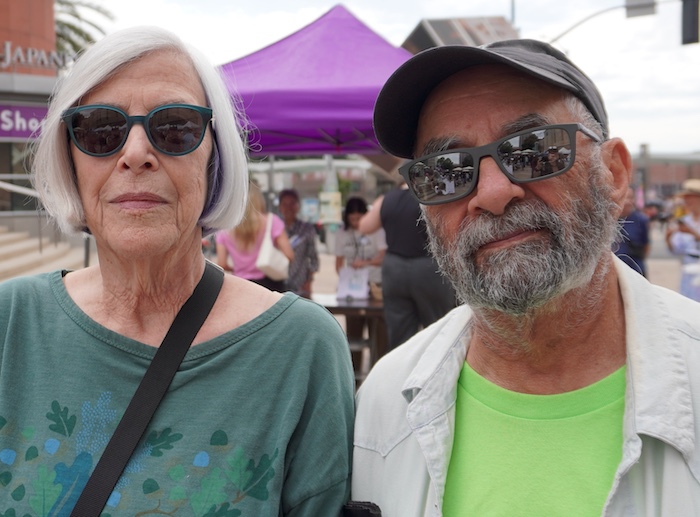
Rosemary Lee and Robert Matano (Photo: George Toshio Johnston)
For retired teachers Rosemary Lee and Robert Matano, showing up to hear the words from representatives of NPCA, the Gabrieleno San Gabriel Band of Mission Indians, JANM, Clergy and Laity United for Economic Justice, Nikkei Progressives, Manzanar Committee and Coalition for Humane Immigrant Rights, as well as individuals who experienced Japanese American incarceration firsthand, was part of something bigger.
“I am appalled that we’re going fascist,” said Lee. “The plan, the Project 2025, is being followed perfectly, and people need to understand that. I would also add that the employees at the parks were the first to go out and protest en masse.”
“I’m for protecting the parks, and I’m for protecting the rights of immigrants, and that immigrants are welcome here,” said Matano. “I hate the Gestapo.”
According to Rich Yamashita, an adult leader of Gardena-based Scout Troop 719, having scouts attend the Day of Action was a fit under the rubric of the Citizenship merit badges, an “opportunity to get our scouts to be involved and be informed about what was going on. … This location here is where we show them where something happened during 1942.”
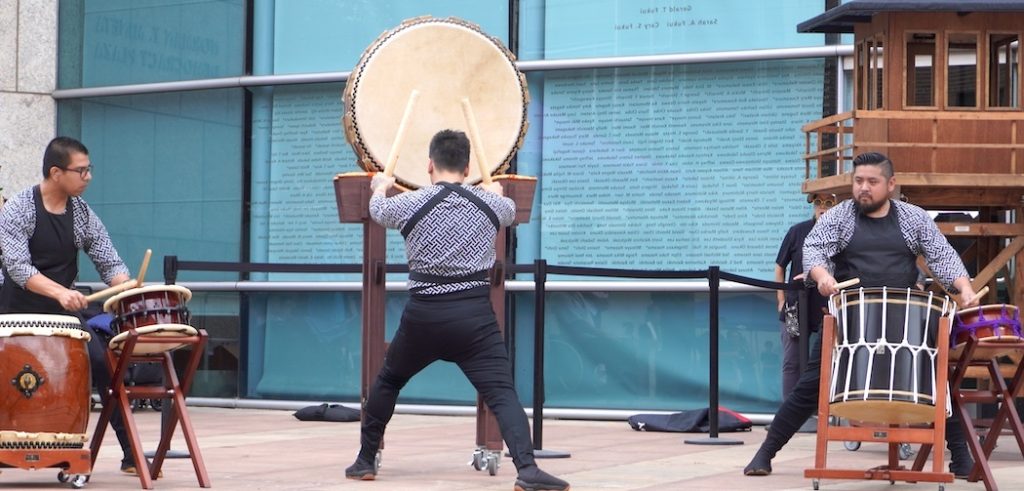
L.A. Taiko Collective (Photo: George Toshio Johnston)
After acknowledging the presence of Albert Lord, representing California Attorney General Rob Bonta’s office, Assemblymember Al Muratsuchi (D–Torrance), Los Angeles Community College District board of trustees President Kelsey Iino and Los Angeles City Councilmember Ysabel Jurado (D-District 14), Heatherton said, “Our history is getting erased before our eyes. We cannot let this happen. We cannot be silenced while this is occurring.”
Next was JANM President and CEO Ann Burroughs, who said, “The implications what’s happening now stretch far beyond America’s historical sites and parks, which is why we have to continue to challenge the revisionist history.”
Speaking to the day’s raison d’être was NPCA Southern California Director Dennis Arguelles, who said, “Our parks play a critical role, preserving and telling the stories that shape our nation, including those chapters where we fail to live up to our own democratic ideals. … This administration’s recent order to supposedly bring sanity back to American history is nothing less than an attempt to impose its own narrow, jingoistic and chauvinistic view of American heritage.”
Referring to the Trump White House, Manzanar Committee member Glen Kitayama said, “They’ve begun to overhaul the National Park Service, the Smithsonian and other public institutions to censor how American history is remembered, presented and taught. … We cannot normalize fascism.”
The next speaker was Tak Hoshizaki, 99, a Korean War Army veteran and one of the 63 members of Heart Mountain’s Fair Play Committee, which advocated for draft resistance during WWII while they and their families were denied equal treatment under the law. For that stance, FPC members were sentenced to “three years in federal penitentiary” until pardoned by President Truman. Alluding to how the story of the FPC had been “swept under the rug” for many years, he said, “Today, we look around and say, ‘The same thing now is happening.’”
Kyoko Oda, 80, who was incarcerated with her family at Tule Lake, said, “Across the country today, our history is in danger of being erased at places like the national monument at Tule Lake and Manzanar. Our government describes it as ‘content correction.’ … We must preserve and protect our national parks’ historical integrity, or there will be no democracy for tomorrow.”
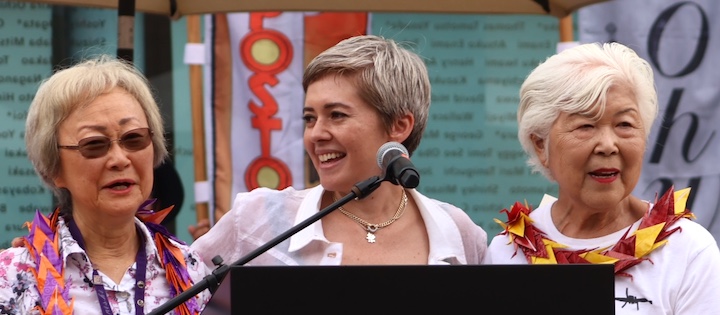
Jeanette Fujita Konishi and Kyoko Oda flank event mistress of ceremonies Dana Fujiko Heatherton as the crowd sings “Happy Birthday” to Konishi, whose 80th birthday coincided with the day’s event. (Photo: George Toshio Johnston)
The event was not all fire and brimstone. Heatherton introduced Jeanette Fujita Konishi and said, “Today is her 80th birthday. There are lots of places she could be today. And she said she needed to be here.” More than 500 voices joined to sing “Happy Birthday” for her. The voices would soon join again as some of the speakers led protest chants.
Speaking next was Nikkei Progressives member Abigail Chun. “The histories of our communities must continue to be preserved and shared, not only for ourselves, but for everyone,” she said. “Our past teaches us the importance of fighting against our erasure, as well as the erasure of others.”
Representing CLUE Justice was Rev. Yoshua “Yoshi” Kuramoto, a pastor at San Pedro United Methodist Church, who told the crowd: “We stand side by side, people of all colors and all religions, across identity lines, firmly against the threats of fascism.”
Vlad Carrasco, director of climate justice for the Coalition for Humane Immigrant Rights Los Angeles, said, “We’re gathered here today in the heart of Little Tokyo because here is where, in 1942, families were kidnapped, separated and sent to internment camps.The struggles of the Japanese Americans in 1942 is clearly connected to the struggles for justice today.”
After hearing the various speakers, Wendy Nagatani shared her thoughts. “It’s important because I think that shows the true nature of history. If they do away with the parks and do away with the museum, then you’re taking away the truth.”
— Ryan Kozu contributed to the Seattle portion of this article.



